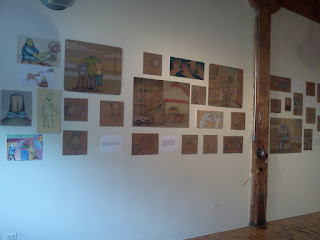1828 E. York Ln.
Sunday, June 23, 2013
Art Practice as Research
My art is influenced by a lot of things; mostly my experiences and the experiences we all have in common. I learn about other peoples experiences and ideas through what I read. This reading becomes my research and influences what I create. Therefore my art is a product of research. The Workers is a culmination of this research process. Along with the work I have included text to guide the viewer in such a way as to prove my point- this is the text that was included in The Workers;
Saturday, June 22, 2013
My First Solo Art Show
Workers
I have not always been concerned with social class although I have been aware of social distinctions most of my life; but until recently, I was largely unaware of the effect that class has had on my every-day existence. Growing up in a largely middle class community in the western suburbs of Chicago I had always just assumed that I belonged to the middle class. We had all of the material luxuries; a house in a nice neighborhood, more than one car, my dad rode a motorcycle, we had a camper and took family vacations, we had decent clothes, went to good schools, went to church... your basic living-the-American-dream suburban lifestyle. Yet, looking back, there always seemed to be significant social differences between me and most of my peers in school and church. I believe one of the biggest differences was that my father turned a wrench for most of his working career while most other dads worked in an office. Did that mean that we were working class? Is “working class” a bad word? Was I excluded from the middle class without being aware?
Over his career my father was able to work his way into sales and eventually upper management on a high school diploma. As he moved up in his career, our family moved up in our accumulation of status symbols but, did it really matter what we owned or where my father worked? Is that what social class is really about? Where did we fit in? What are the indicators of social class? How are social distinctions in our culture defined, what are the lines? How does social mobility work? Can we ever truly be socially mobile? How do people in our culture identify themselves within the American caste system? What is the history of that system? Is there a system at all?
Workers explores the issue of social class using arts-based research as a method of inquiry. The artwork in this show is based on memories of my family, their stories and our shared experiences in work, life, and relationships. There is also considerable influence from both scholarly and popular literature that is concerned with issues of social class in our country.
The central figure in Workers is a representation of a working class stereotype, an idealized form that represents “the worker” and relates some of the assumed characteristics of a working class existence from my personal experiences and the experience of others. The drawings are based on my interpretation of past events in my life; memories, wishes, and people who are important to me. The formless faces connote the individual but never give the individual an actual identity... for instance, if the power goes out, we call ComEd and report the outage, an hour later the power comes back on and we go on with our daily lives. What we take for granted is the person who actually went into the wires and sorted everything out; for us that person has no name, no face, just the result. We don’t know who the person who actually went out and fixed the problem is; and usually we don’t care- someone did it.
Social class is multidimensional and encompasses political, religious, gender and racial issues. Workers will not be able to address these issues in full; instead it will concentrate on social class while keeping in mind that there are many forces that shape our experience. These forces inevitably make an appearance in the work and have a say in the direction the project moves. Workers is only a start; it is an effort to gain a better understanding of social class, how we live together, and how we can make our shared experiences more meaningful. After all we are in this world together.
Subscribe to:
Comments (Atom)




























